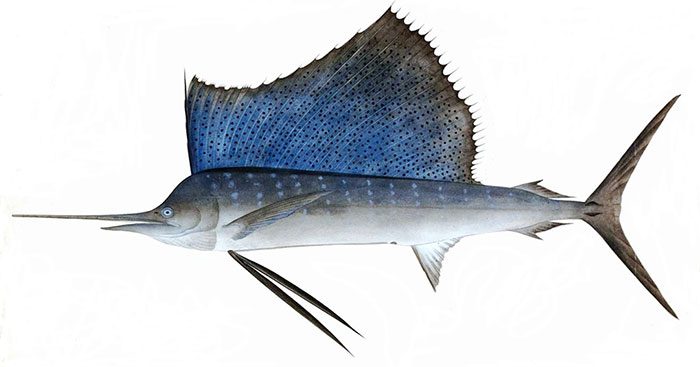What truly sets this fish apart is its system of numerous fins arranged precisely along its body.
The Speed King of the Ocean
There are thousands of fish species in the ocean, but only one has retained the title of the fastest swimming fish for centuries. That fish is the sailfish, scientifically known as Istiophorus platypterus.

Sailfish can reach speeds of up to 125 km/h underwater. (Photo: Getty).
The name of this fish is inspired by its large and distinctive dorsal fin, which resembles the sail of a ship.
This species lives in the warm waters of the Indian and Pacific Oceans. Thanks to its streamlined shape and powerful tail, it can push through the water and reach maximum speeds of up to 125 km/h.
This speed is comparable to that of the cheetah, known as the fastest land animal. Hence, they are nicknamed the “speed king” of the plains.
Sailfish typically attack smaller fish by darting towards them and using their sharp, elongated bill to stab their prey.
The sail of this species is usually folded down while swimming and is only raised when attacking prey. Raising the sail has been shown to reduce lateral head movement.
This likely helps the prey remain unaware of the approaching predator. Consequently, this strategy allows sailfish to get close to schools of fish or even swim into the midst of them without being detected before launching their attack.
In most cases, sailfish do not kill their prey immediately but rather severely wound them. This reduces the swimming speed of the victim, leaving them vulnerable and eventually leading to their demise at the hands of the predator.
Structural Differences

Distinct structure of the sailfish with its numerous fins. (Photo: Wikipedia).
Being the fastest fish in the water has made the sailfish a subject of study for scientists over a long period.
They soon realized that what truly distinguishes them from other fish species is their system of numerous fins arranged precisely along their body.
Here, their dorsal fin resembles a sail protruding from the back, while the pectoral fins on either side play a crucial role in navigation and speed stability.
Meanwhile, the tail fin and anal fin of the sailfish provide forward propulsion. This is essential for achieving superior maximum speeds.
Overall, this fin system helps sailfish glide through the water with minimal resistance, similar to how many land animals tuck themselves to reduce wind resistance while running.
Below the sleek body of this fish are perfectly arranged bony spines, which enhance structural integrity, allowing them to achieve explosive speeds without damaging their internal organs.
Although they can use speed for hunting and effectively evade enemies, sailfish remain on the list of vulnerable species.
This is because they depend on coral reefs for feeding and breeding. Meanwhile, coral populations in many areas are showing signs of damage and decline, leading to the disappearance of this species from those regions.




















































